Travel book
This page will be actualized soon!
Here I will tell you some anecdotes about my trip, to give you the feeling of visiting Peru too!
12/7/2013 : Peruvian Gastronomy
Peru has perfect conditions for fruit and vegetable growing all along the year. Thanks to various altitude stages and geographic Ecuador proximity, the country has various microclimates – from permanent snow to tropical jungle – and species. Humboldt cold water current which flows into Pacific Ocean close to Peruvian coast brings a huge variety of fish and shellfish.
Peruvian regions map @ Mixha Zizek
NORTH COAST: Tumbes, Piura, Lambayeque, La Libertad
It can be recognized thanks to it strongly marked characteristics which deal with its agriculture and fish production. Among them, we can highlight dried meat of calf, yuccas, sweet potatoes, beans, peanut and carob. Bananas are used in dish preparation like seco de chavelo – dish with dried meat – or chips. To prepare marinades, the most important ingredient is chicha de jora – fermented maize drink. Typical cuisine differs according to social and economical classes.
Ceviches: marinades of black seashells, shellfish or fish
Chinguirito: kind of ceviche with dried meat, salad and pieces of ray prepared with lemon, pepper, onions and chili powder.
Sudado: fish cooked with vapor
Meat: seco de cabrito – dried meat of goat – with beans or green tamales – maize paste –, seco de chavelo, rice with duck
Other dishes: yucca chips, seashells with parmesan, fruit and vegetable chips and jellies, causa en lapa – potatoe pate.
Banana chips, ceviche and seco de cabrito with beans
LIMA:
Fish and shellfish: tiradito (raw fish with salsa), parihuela (fish soup), rice with shellfish, fish a la chorrillana (fried fish with tomatoe sauce), oysters a la chalaca (oysters with lemon, onions, tomatoes and maize)
Drinks: chicha morada (purple maize drink), beer, pisco sour (pisco cocktail with lemon juice)
Creole cuisine: causa from Lima, tamal, chili chicken, stuffed potatoe, roasted chicken, escabeche (vinegar and oil marinade), carapulcra (dried potatoes with meat and sauce), stews
Other dishes: Lima whisper (dessert), purple maize puree, milk rice, turron de Doña Pepa (cake), picarones (donuts)
Causa, Lima whisper
Roasted chicken
SOUTH COAST: Ica, Arequipa, Moquegua, Tacna
Drinks: pisco (strong alcohol of grapes) and wine
Spicy marinades: pork or calf, lamb or duck
Locro: stew of calf or lamb
Other dishes: stuffed paprikas, soltero de queso (salad of cheese, olives, maize, tomatoes, paprikas and onions), ocopa (potatoes with peanut salsa), chicharrones (pork fat fried meat), crayfish soup, fried calf
Stuffed paprikas and spicy marinade
Crayfish-like ceramic plate
LA SIERRA (mountain): Cajamarca, Amazonas, Ancash, Junin, Pasco, Huancavelica, Apurimac, Ayacucho, Cusco, Puno
In ancient times, Andes were the biggest center of plants cultivation, with native species like maize, tubercles, cereals, fruit, vegetables, dried fruit and a lot of aromatic plants. Pre-Hispanic culinary traditions are preserved:
– Preparation of chupes (soups) and stews (carapulcra is considered as the oldest Peruvian stew)
– Food processing: salt fish, toast maize – Cancha salada (popped and toasted corn) is the simplest and most famous Peruvian aperitif until now – or peel grains to dry them – to obtain mote, cooked maize.
In Peru, there are close to 3000 species of quinoa
Charqui was one of the preservation techniques the most used. It consists of salt and dry meat so that it can last several months without refrigeration. In Peruvian mountain, it was common to store potatoes by freezing them in altitude. Another technique of storage is drying or tocosh, potatoes kept in pounds close to water currents until they literally decay. Then, they are very useful, not only for cuisine, but also for medicine.
Potatoe cooking, under stones
Cuchicanca: young tender pork blanched with vinegar and put into the oven, served with potatoes and mote
Potatoe a la huancaina: potatoe served with local cheese made in churn and colored chili.
Patasca: mote soup
Potatoe a la huancaina and patasca
Puka picante: blanched pork and potatoes with colored chili and beetroots
Huallpachupe: chicken soup from Cusco
Inchik uchu: blanched yucca with peanut salsa, chili and coriander
Other dishes: guinea pig roasted on a spit, maize with Andin cheese, maize salad, mote with chicharron, cancha, humitas (cooked maize paste)
Puka picante, huallpachupe and guinea pig
LA SELVA (jungle): Loreto, Ucayali, San Martin, Madre de Dios
They use meat from captured animals while hunting. Among them: dear, boar, peccary, tapir, tattoo, picuro (kind of big rat), agouti (rodent)… It is prepared in different ways: roasted, blanched, in soups, fried… Juane is a dish which is appreciated in the whole region, and so are dishes made with banana. The network of rivers brings fish like paiche, the biggest one of Amazon rivers. It can weigh up to 180kg and its white meat is delicious.
Tacacho of dried meat: bananas in the ember with chicharron, onions and dried meat
Stuffed banana: banana paste stuffed with calf meat and peanuts
Patarashca: fish wrapped in banana leaves and roasted in fire
Juanes: rice paste with chicken pieces, wrapped in bijao (sort of palm tree) leaves and eaten with chopsticks
Roasted picuro: rodent of delicious meat
Apichado: glazed pork pieces stewed with peanut powder and maize
Carachama stock: carachama fish with bananas and coriander
Uvachado: soaked grapes
Chapo: banana cooked in water and milk
Inchicapi: chicken, peanut powder, coriander and yucca
Drinks: artisanal ciders and wines, maize or quinoa chicha
Other dishes: chonta salad (fruit from palm tree), chuchuhuasi (plant), caterpillar soup
Juanes, chonta salad, carachama stock, patarashca, dried meat tacacho and inchicapi
Caterpillar soup
Finally, there are different sorts of breads…
French bread
Traditional turron
Empanadas (meat turnover)
Bakery oven
This presentation was made thanks to the picture I made at the Peruvian Gastronomy Museum of Lima.
11/1/2013 : El Dia de los Muertos
Death day in Peru, like often in Latin America, cannot be compared to our Death day in Europe. It is not celebrated on the same way according to the different countries and even the different regions of Peru.
Peruvians, above all those from the “Sierra” (mountain), prepare food and bring it with them at the graveyard. They sit around the grave and eat and drink with the dead. The plates are mainly what the dead liked. Sometimes, some food is left on the grave for him or her. People can also sing, dance or play music! The feast is quite happy.
The graveyard gets colourful with flowers and people
The most amazing is that inside the graveyard, people sell flowers, water for flowers, candles, food… And beer! Sometimes, people get too drunk and “corpses” can be found near graves on the next day…
We can even go to our grave by moto-taxi!
The biggest graveyard of whole South America is the one of Esperanza, in Villa El Salvador, South of Lima. Graves can be from flats where the whole family is burried together to simple amounts of stones with cross. The graveyard is so huge that it goes up the first Andes mountains.
Esperanza graveyard
More and more houses are built around, made of almost nothing. Lima is overcrowded, so people live where they can afford. Inside the valley, people breed pigs, where the stinky atmosphere doesn’t bother inhabitants. They live just next to their cattle, in houses without water nor electricity.
Under these black roofs are bred the pigs
This graveyard stands on a sand desert. Dust is everywhere, and winds due to temperature difference between oceanic air and mountain air bring columns of sand and garbage! In fact, the graveyard is a real bin, where birds are plastic bags.
A dust column of wind, which can rise very high!
To conclude, someone told me something like: why should we cry dead people along the whole year if we have el Dia de los Muertos to meet them again like before?
10/27/2013 : El Senor de los Milagros
About 90% of Peruvians are catholic, but above all, they celebrate Saints. For example, October is entirely dedicated to “Miracles Lord”. People pray the Saint to cure diseases, solve their problems…
One day, a painter represented the Saint on a church wall. A terrible earthquake destroyed the church, except this wall. Since then, people make processions to venerate the Saint in every Peruvian town, and even in some foreign places where Peruvian community is important.
The church where the Saint was represented, in Lima center.
During the processions, everyone is in purple. Some women carry censers, others sell turron (kind of cake, nothing to see with our nougat). Some men carry the heavy statue of the Saint across the city. Pictures made of chalk of flower petals are drawn on the ground where the procession goes. Some children are carried so that they can touch the Saint statue.
Women with censers
Men carrying the statue. It’s heavy!
Drawings on the road for the procession
14/10/2013 : Departure to Madrid with bus. My plane to Lima takes off from Madrid, it is cheaper. It’s hard to leave my family and my house!
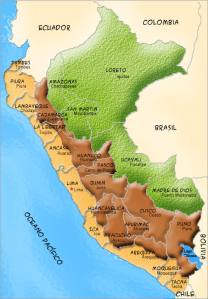

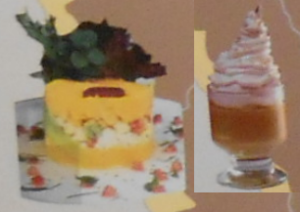
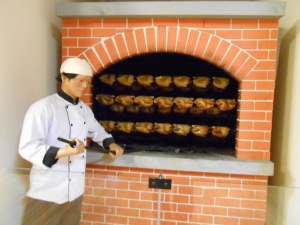
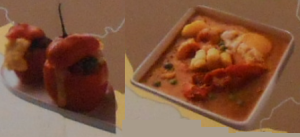
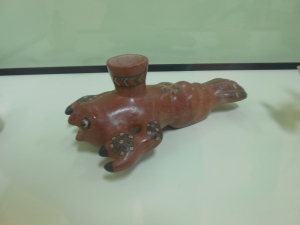
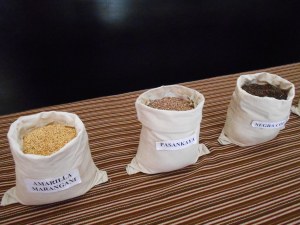
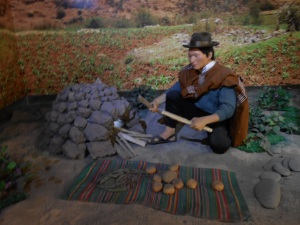
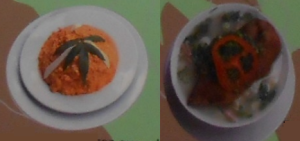


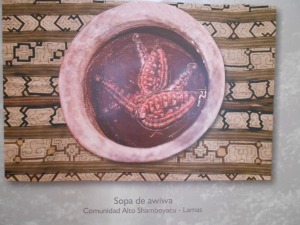
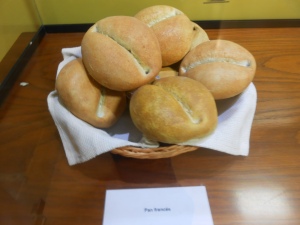
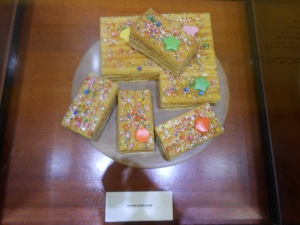
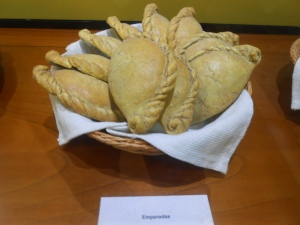
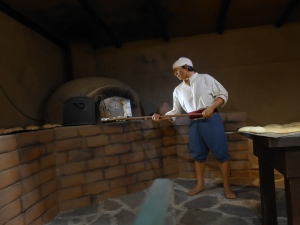
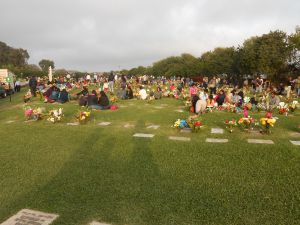
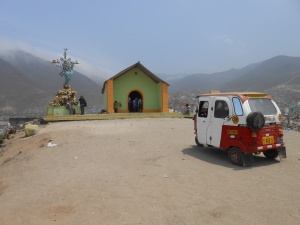
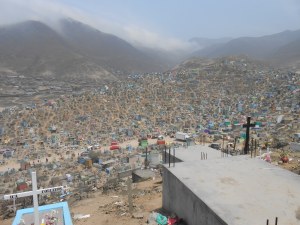
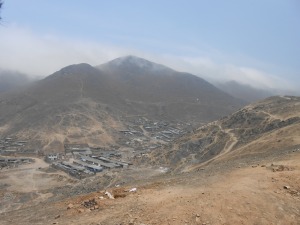
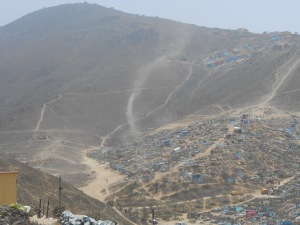
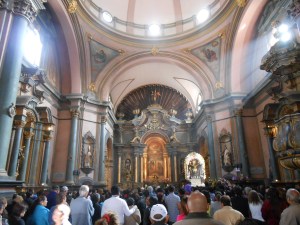
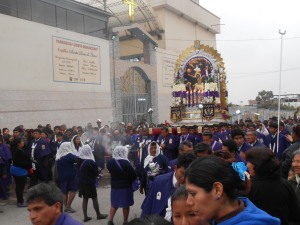
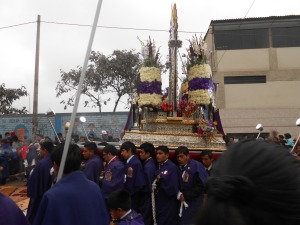
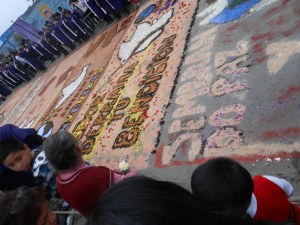

Leave a comment